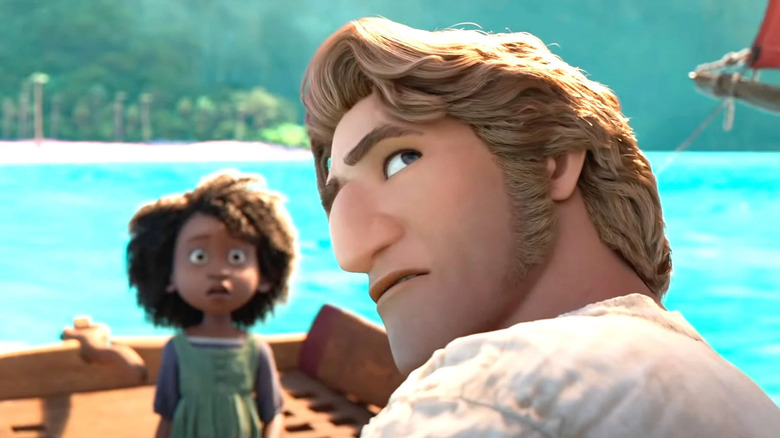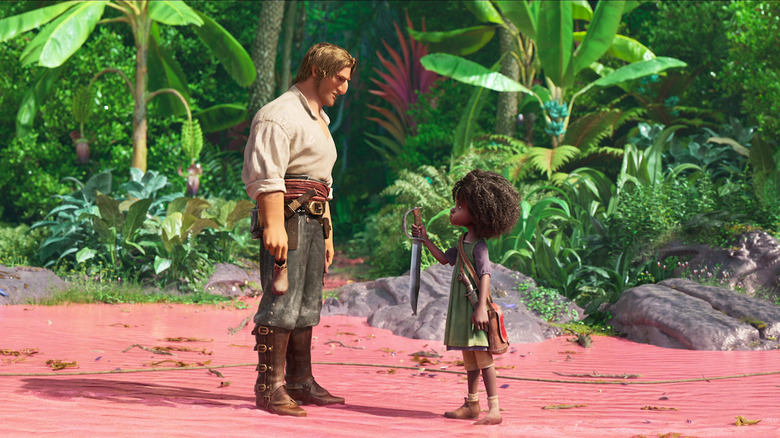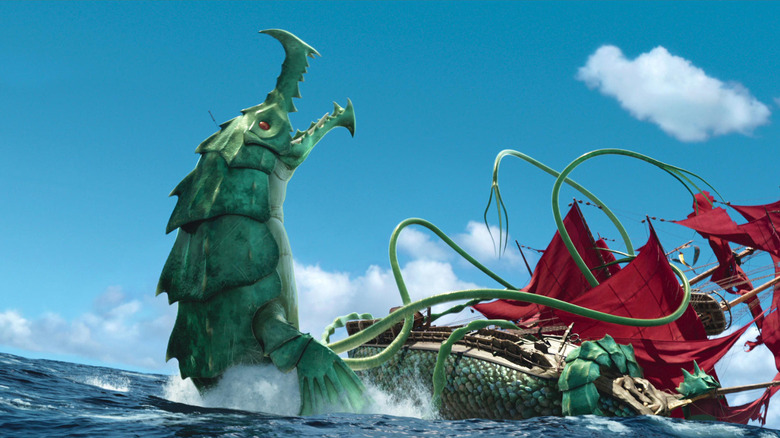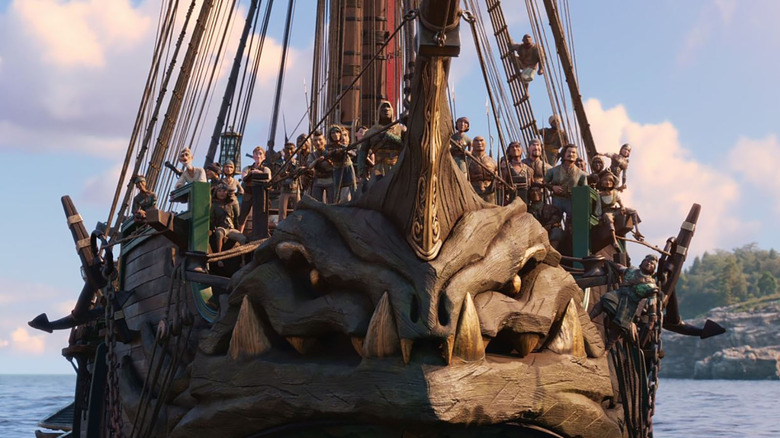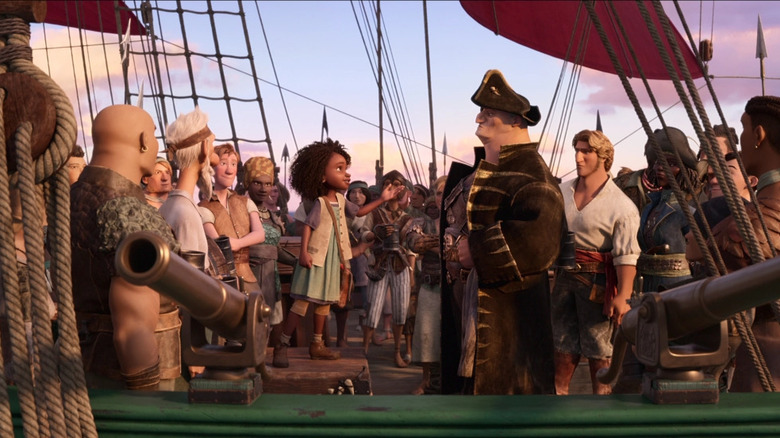The Sea Beast Animation Director Zach Parrish On Trusting The Process And Making Epic Animation [Interview]
Zach Parrish knows a thing or two about what it takes to make a phenomenal work of animation. The director of the moving Disney short film "Us Again," Parrish recently served as the animation director on the upcoming Netflix animated epic, "The Sea Beast." The story of a swashbuckling monster hunter and his crew as they face down their most challenging adventure yet, "The Sea Beast" comes from director Chris Williams ("Bolt," "Big Hero 6," "Moana"), who brought on Parrish to help bring the film to fruition.
"The Sea Beast" is a larger-than-life project that required some larger-than-life talent to pull it off. Thankfully, that's exactly the type of animation director Parrish is, and "The Sea Beast" looks, quite frankly, incredible. We sat down with Parrish to get a little more insight into his work on the project, and discuss the complexities and beauty of working in the animation medium.
'Animation is sort of like playing with action figures'
You also just made the absolutely brilliant short film, "Us Again," and it came out not that long ago. Was there any overlap between working on that project and "The Sea Beast?"
Parrish: There was not really any overlap, because we finished "Us Again" actually pretty early. It wasn't released in theaters until March. We had finished it the previous August, I believe, September-ish. So I'd actually been off of that show for a while. I worked on "Raya and the Last Dragon" after that at Disney. And then Chris [Williams] gave me a call on this film right at the end of "Raya." I was in between projects anyways, and I was really excited by working with Chris again, by his pitch for the story, and so I got brought on. I was brought on a little late into production. Shots and animation had just begun on the Imageworks side. But it was, as you've probably seen, such a big film. It needed a lot of support just to get it to the finish line. So I was happy to get to jump in and help.
So between the ships, the water, the monsters, and the fact it's a period piece, were you intimidated at all when you got this pitch knowing, "Wow, there's a lot of animation going on here?"
Parrish: A hundred percent. Yeah. From a complexity standpoint, it was like, "Whoo, that's a whole lot of movie." But I think my excitement for the film won out over that fear. Because there was also this potential for much more nuanced acting, because Chris wanted to go for a more mature tone. There was the wish fulfillment of getting to do these big epic action scenes on a boat. I often say that for me, animation is sort of like playing with action figures when I was a kid. So this was like the most epic, fun toolbox of little action figures to play with. While it was daunting and the task was large, it was just so fun to get to jump in the water and play.
Animation is not just for kids
I like that you mentioned that this has a little bit more of a mature story. I'm assuming you probably had a lot of feelings on Oscar night when they insinuated that animation is just for kids. I'm curious if you could speak on that?
Parrish: Yeah, that was a really tough night in a lot of ways, especially not having "Us Again" there. But then, yeah, that implication and the laughter in the room, too, about that joke was really frustrating. Because oftentimes animation's referred to as a genre, and it's not. It is its own medium, but it's filmmaking. And there are film genres within animation. This is an epic action film that has a really emotional core to it. And it is one of the most mature films that I've worked on. You know, obviously there is animation that is for kids. That is a thing that exists. There's also live-action that is made for kids. They're both film in my mind. They're both content, they're both storytelling. All it did for me was motivate me to work harder and to keep making better and better stuff. But it is still a hill we have to climb.
Animation as a medium is, I think, the definitive example of "trust the process." As an animation director, how do you pivot your mindset with, "Okay, yes, this kind of looks rough right now. There's no lighting, there's no texture," without freaking out?
Parrish: I think that comes with experience. I've been in this industry for almost 15 years. So you've seen really ugly stuff become really beautiful things. And it really is just part of that trust in the process. I think a lot of tools and things like that have been created to help try to ease that burden, especially for people who are newer to the process and are going, "But it's not really going to look like that, right?" You're like, "No, no, no, it's not going to look like that." But I think you have to know what you can control at every step, and what each step is asking of you. And in the animation department specifically, it's about the form. It's about the appeal. It's about the performance. It's about the emotion. It's about the connection with the audience. Because you trust that there is a game plan for the lighting and the cloth and the water and all of that. You know it's going to be epic. Then it also comes down to a lot of collaboration with departments, both upstream and downstream from you, to bring up problems. If they happen to kick stuff back to you, to collaborate on things early on so that we don't get into a problem, it just involves a lot more communication. And the more experience all of those people have, the better it is.
Working in animation means always learning
With animation, as well as a medium and as an art form, the technology in the last five years, even, has just skyrocketed. There's so many more options. How do you personally keep yourself up to date with all of these changing technologies and continuing to perfect your craft?
Parrish: It is one of those things where, yeah, it does feel like you're constantly behind, and you're constantly needing to learn. Which is, honestly for me, the most exciting part. I never really wanted to get complacent and to redo what I had done in the past. It was one of the reasons I joined this film. It was a new adventure similar to the story, I suppose. It was new people, it was new technology, and all of that to me is really exciting. But the short answer is a lot of time on the internet, I guess, just seeing what everybody else is doing. Social media, Instagram, LinkedIn, things of that sort, where people are constantly sharing the things they're inventing, the way in which they're using tools to create new things is both educational, but also inspiring.
It's like, "Oh my gosh, I didn't even think about the fact that we could use that. But what if we use that like this?" So it can constantly be fulfilling itself in that kind of inspiration. But it is a lot, because there's so many people doing such amazing work now. That's why we were super excited to get to work with Sony Imageworks. They're at that front edge of "Spider-Verse" and everything else that they've been doing like "The Mitchells vs. The Machines" and now "The Sea Beast." They really do have the pipeline, the infrastructure, and the people to really pull off whatever is asked of them.
"Mitchells" was one of my favorite films of last year. I was really insufferable about it.
Parrish: [laughs] Same.
Making a movie from home
You've talked about how difficult and collaborative this effort is, and part of "The Sea Beast" had to be done from home. What was that like?
Parrish: It was weird, because I got brought on post the beginning of the pandemic. We had 180-plus animators mostly in Vancouver on the Imageworks side, and I've never met any of them in person.
Wow.
Parrish: The only person I've met in person is Josh Beveridge, who is the head of animation on the Sony side. And I saw Chris [Williams], the director, twice in person. So it meant that we had to communicate a lot more clearly. There's a dynamic of in-person conversation that is a little bit more flowy. It's easier to understand where people are coming from body language and things of that sort. So it did require a lot more clear, articulate communication. But fortunately, Sony has been working this way for a long time. Even before the pandemic, they had this ability to work remotely. So they had the tools and they had the infrastructure for all of us to work off of. We could all look at the same image at the same time, and we could all draw on the same image.
So the communication piece was a learning curve, but the actual interaction was actually very intuitive and very easy. We were surprised when we got to see it on screen that everything translated pretty well. We saw it on the big screen, we're like, "Oh, it actually looks pretty good." 'Cause we've been looking at it on a little monitor all this time. But the team really took it in stride. They did an amazing job. But yeah, it was this. We're all used to this now.
"The Sea Beast" arrives on Netflix on July 8, 2022.
